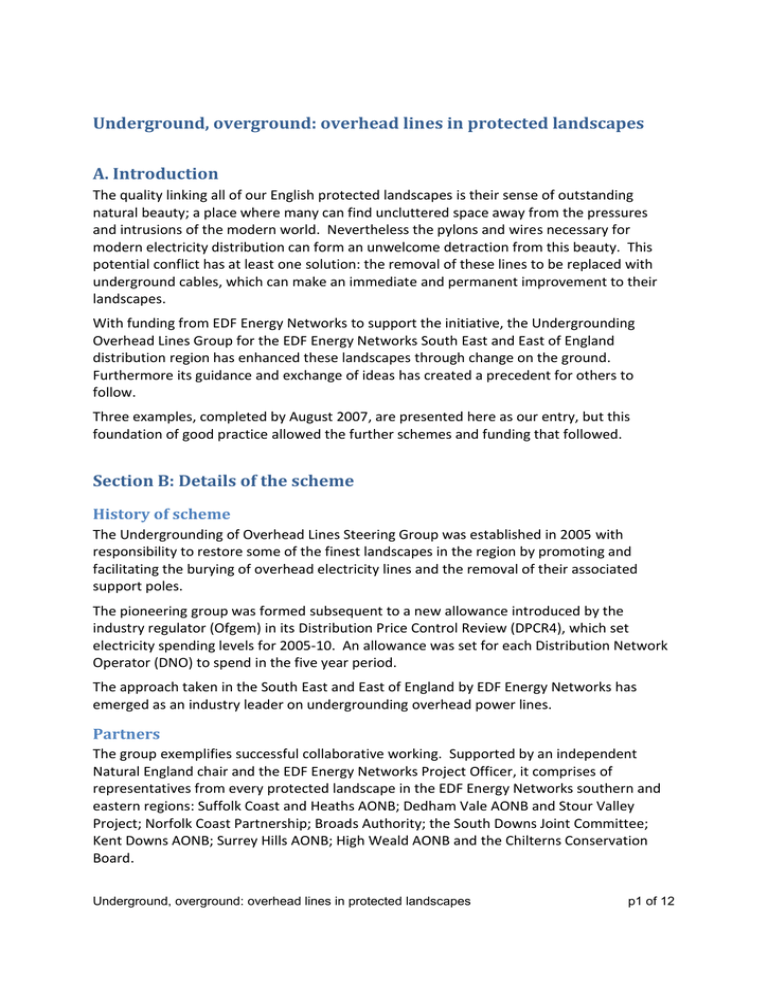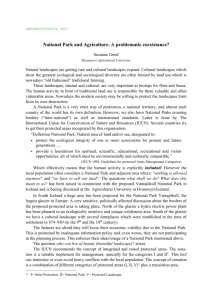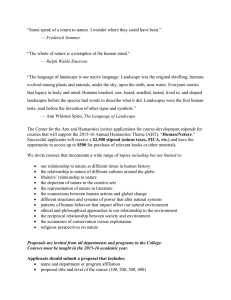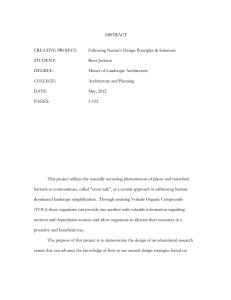Underground, overground: overhead lines in protected landscapes
advertisement

Underground, overground: overhead lines in protected landscapes A. Introduction The quality linking all of our English protected landscapes is their sense of outstanding natural beauty; a place where many can find uncluttered space away from the pressures and intrusions of the modern world. Nevertheless the pylons and wires necessary for modern electricity distribution can form an unwelcome detraction from this beauty. This potential conflict has at least one solution: the removal of these lines to be replaced with underground cables, which can make an immediate and permanent improvement to their landscapes. With funding from EDF Energy Networks to support the initiative, the Undergrounding Overhead Lines Group for the EDF Energy Networks South East and East of England distribution region has enhanced these landscapes through change on the ground. Furthermore its guidance and exchange of ideas has created a precedent for others to follow. Three examples, completed by August 2007, are presented here as our entry, but this foundation of good practice allowed the further schemes and funding that followed. Section B: Details of the scheme History of scheme The Undergrounding of Overhead Lines Steering Group was established in 2005 with responsibility to restore some of the finest landscapes in the region by promoting and facilitating the burying of overhead electricity lines and the removal of their associated support poles. The pioneering group was formed subsequent to a new allowance introduced by the industry regulator (Ofgem) in its Distribution Price Control Review (DPCR4), which set electricity spending levels for 2005-10. An allowance was set for each Distribution Network Operator (DNO) to spend in the five year period. The approach taken in the South East and East of England by EDF Energy Networks has emerged as an industry leader on undergrounding overhead power lines. Partners The group exemplifies successful collaborative working. Supported by an independent Natural England chair and the EDF Energy Networks Project Officer, it comprises of representatives from every protected landscape in the EDF Energy Networks southern and eastern regions: Suffolk Coast and Heaths AONB; Dedham Vale AONB and Stour Valley Project; Norfolk Coast Partnership; Broads Authority; the South Downs Joint Committee; Kent Downs AONB; Surrey Hills AONB; High Weald AONB and the Chilterns Conservation Board. Underground, overground: overhead lines in protected landscapes p1 of 12 How it worked Nominations for potential schemes were received from a number of landowners, protected landscape staff and parish councils and, most importantly, the general public. This method empowered local people to become involved with landscape restoration and to promote the value of the work to their local landscapes. Each proposed site was visited and using a set of criteria established by the group1, the benefits for landscape, heritage, biodiversity and the cultural impact of a scheme were assessed against the complexity of the proposal, value for money and evidence of public support for the project. At this stage the technical input from the dedicated EDF Energy Networks officer provided a steer on the proposal’s viability, but additional steer was also sought from the partnership or committee meetings of individual protected landscapes. Draft schemes were then presented to the steering group to vote on whether the scheme should proceed further. Following this, full consents were sought from partner agencies and local landowners involved, allowing the scheme to be brought back to the group in a final format for a decision on giving the project the ‘green light’. Press releases working in partnership between the protected landscape, EDF Energy Networks and Natural England were made for each scheme and the newsletters of the protected landscapes ran further stories upon successful completion. What it has achieved Since the establishment of the group in 2005 our approach to this project has proved extremely successful. During the first year of the scheme our constitution and policies were agreed and schemes started to take shape. By August 2007 three schemes had been fully undergrounded : Buckenham Pump, Broads Authority Burnham Thorpe, Norfolk Coast AONB Quarry Hangers, Merstham, Surrey Hills AONB This initial experience facilitated during the 2005-10 project period completion of a further 21 schemes, translating to removal of 54.2km of overhead lines and 695 poles, and resulting in immense visual improvements to some of the best-loved landscapes across the region. All across the distribution area the scheme has remedied the damage caused by the clutter of overhead power lines and restored the natural beauty and the wonderful sense of wildness back to these special places. Details of three schemes The photographs highlight the benefit of the project work undertaken, which are detailed below. Burnham Thorpe, Norfolk Coast AONB Burnham Thorpe is a small West Norfolk village, a Conservation Area on the River Burn. It is an important site of cultural significance, mentioned in the Domesday Book of 1086 and 1 Further details of how these criteria work are contained in the appendices. Underground, overground: overhead lines in protected landscapes p2 of 12 famous for being the birthplace of Vice Admiral Horatio Nelson, in whose honour Norfolk is known as ‘Nelson’s County’. The site of Nelson’s birthplace, celebrated in typical Norfolk low-key style with a simple roadside plaque, is located amongst a group of attractive vernacular buildings edging a narrow country lane and overlooking the River Burn valley. Local public rights of way, well used by locals and visitors, provide an opportunity for people to take a walk along the riverside. The Joint Character Area for North West Norfolk captures the intimate pastoral character of the river valley, which is centred on the narrow, winding River Burn, with its adjacent floodplain water meadows, mature ancient trees and riverside scrub. A dominating network of overhead lines, accompanied by poles, steel brackets and bulky transformers, had cut across arable land, through the shallow valley of the River Burn arriving in front of the attractive building frontage, Nelson's birthplace and ‘The Parsonage’ (a Grade II listed building). Therefore in 2007, the draft Character Statement for the Conservation Area identified 'the clutter of poorly designed street furniture and overhead wires' as a significant visual detractor from the special quality of the area. Visible from the public rights of way and from the surrounding narrow lanes, they also significantly detracted from the river and water meadow character of the river valley. The local community, the parish council, the local planning authority, the landowner, the tenant farmer, the Norfolk Coast Partnership (of the Norfolk Coast AONB) and EDF Energy Networks (with active support from British Telecom) worked together to agree an improvement plan. As a result, 800metres of overhead lines, their poles, pole-mounted transformers and switches, plus overhead services to four buildings were replaced with 850 metres of underground cable. At an estimated cost of £40,829, the whole ‘wirescape’, including telecommunications wires and poles, was realigned to minimise the past damage, and enhance the quality of the landscape for the local community and visitors. “I am a Norfolk man and glory in being so”, said Lord Nelson and by restoring the landscape of his birth this project has helped to increase the local pride in it. Buckenham Marshes, the Broads Authority Buckenham Marshes was the first ever scheme completed by the project,and seen as a great step forward in restoring the wildness and beauty of the area and the setting of Buckenham Mill. With the line crossing an internationally important biodiversity site, designated for significant bird populations, previous concerns had lead the RSPB’s site management plan to propose their undergrounding. Tim Strudwick, site manager for the RSPB’s Mid Yare nature reserves had welcomed the move: “We expect this change to benefit breeding waders like lapwings and redshanks as the lines and posts are used as perches by crows that take eggs. It will also greatly improve the look of the marshes and reduce the risk of swans and geese hitting the wires.” Underground, overground: overhead lines in protected landscapes p3 of 12 The scheme, completed between August and October 2006, replaced 860metres of 11,000volt overhead power lines with 2.3km of underground cable. Quarry Hangers, Merstham, Surrey Hills AONB Quarry Hangers is set in classic chalk downland scenery within the Surrey Hills AONB. The site itself is a Site of Special Scientific Interest (SSSI), important for its orchids and butterflies and well-loved by local people for quiet recreation. Robin Gater, on behalf of Bletchingley Parish Council, said the parish were “very keen to support this project that enhances the landscape of our parish, which is a pleasure to the indigenous population and visitors alike.” Alec Baxter Brown and volunteers from the Downlands Countryside Management Project offered his wholehearted support for the proposal to have the power lines placed below ground. He said the project would “benefit this most valuable site by considerably enhancing the experience of visitors and by making this site safer for leisure activities”. Work between July and August 2007 removed 400metres of line and poles at a cost of £17,000. Birling Gap Birling Gap is evidence of how the good practice in early schemes influenced design of the even more ambitious later ones. Birling Gap is located west of Beachy Head, which rises 162 metres above the sea and is the highest chalk sea cliff in Britain. The “gap”, a former river valley that created a dip in the chalk cliffs where the Downs meet the sea, historically formed an easier transport route from the sea. This cliff shoreline, known as the Seven Sisters, is part of the Sussex Heritage Coast and is within the new South Downs National Park. Birling Gap is a high profile destination for tourists, because of easy access from Eastbourne and being located on a bus route actively promoted to tourists. In addition it is located on the South Downs Way and an easy-access trail past Beachy Head to Eastbourne. The works removed 2.6km of 11,000 volt overhead power lines and replaced them with 3.2km of underground cable. Work commenced in October 2008 and was completed in March 2009. C. Evidence against criteria 1. Sustainability Overall these individual schemes have positively changed the landscape in these areas, as shown by the three examples. Against the entry criteria additional detail is given below. a. is part of a sustainable development policy The actions illustrated within the three schemes are part of the DPCR4 investment to positively improve the visual amenity and character of protected landscapes. This allowed EDF Energy Networks to underground the lower voltage power lines network within these outstanding landscapes. Underground, overground: overhead lines in protected landscapes p4 of 12 Each protected landscape has its own statutory management plan and associated action plan. The funding from DPCR4 allowed the actions identified within individual plans to be implemented. For example, the 2004 Norfolk Coast AONB plan, to produce guidance for the location and design of utilities, was transformed into practical action. b. demonstrates environmental, economic, cultural sustainability; This scheme implementation was governed via the formal constitution of the undergrounding partnership, whose members oversaw the scheme application process and assessment criteria, giving both local action and wider thinking in governance. The initial assessment criteria of the scheme and the subsequent careful peer review by the steering group ensured that the schemes not only provided maximum benefit to landscapes, but also that wider benefits for heritage, wildlife and local people were gained a www “win-win-win “outcome, as shown in the three examples. High quality environments are inextricably linked to economic benefits. For instance, a study by East of England Tourism (2008) estimated 14 million trips and a spend of £730 million per year due to protected landscapes in the East of England. In addition the Association of National Park Authorities (2010) stated that for electricity customers in English National Parks undergrounding benefited customers, both in terms of landscape character, but also security of supply in these rural areas. c. remedies any past damage The existing damage was assessed both on the basis of landscape character and visual impact. For many schemes the separation is significant as the impact on character is often more fundamental than visual for the natural beauty of an area. Resources were targeted where impact was severe i.e. dominant or highly significant. The before and after shots illustrate this point for the three schemes. The statistics of the wider DPCR4 for power lines undergrounded are set out below. DPCR4 TOTALS EPN DPCR4 SPN DPCR4 Totals Totals 33kV OHL removed (km) 1.580 0 11kV OHL removed (km) 16.187 32.857 LV OHL removed (km) 0.650 2.955 33kV towers/poles removed 20 0 11kV poles removed 202 389 LV poles removed 20 64 Pole mounted transformers removed 20 54 Pole mounted switchgear removed/relocated 11 17 Overhead services removed 20 22 33kV underground cable installed (km) 1.630 0 11kV underground cable installed (km) 19.539 37.886 LV underground cable installed (km) 0.755 4.755 Underground, overground: overhead lines in protected landscapes p5 of 12 Ground mounted substations installed 20 52 Underground services installed 20 21 d. enhances the existing landscape These popular schemes gained positive press coverage, with the completion of each scheme being reported in newspapers, on television and on the radio, helping to raise people’s awareness of protected landscapes locally and nationally. Although our results may look impressive on paper, the real success can be judged from the feedback received from the many members of the public able to once again appreciate these special landscapes without the clutter and distraction of overhead lines. In response to the work Tim Harrold, Campaign to Protect Rural England (Surrey), stated: “CPRE Surrey wholeheartedly supports the work being done under the EDF Energy Networks initiative. Congratulations to all concerned on the excellent work that has been done in the past, and hopefully will continue into the future.” David Kennington, National Trust property manager for the Surrey Hills, said: “We welcome the initiative and wish it every success. We are enthusiastic supporters of the concept of removing unsightly pylons from the landscape.” 2. Being an exemplar The group’s constitution states that it will keep others informed of work by sharing good practice with other providers and protected landscapes so that other areas are encouraged to set up similar projects. For example at the end of DPCR4 a project review was conducted to allow others access to lessons learnt (EDF Energy Networks 2010). The work and good practice in the EDF Energy Networks area has influenced the involvement of other regional power distributors. With Western Power Distribution’s commitment in its’ business plan to participate in Ofgem’s DCPR5, funding for works has been secured, with coordination from the South West Protected Landscapes Forum. In a “wirescape” BT Openreach wires are often mixed with electricity wires. For the fullest landscape benefits both need to place their own cables underground to leave a wire free landscape, which has often been achievable, using the scheme’s positive influence. For example within the Burnham Overy scheme, we worked closely with BT to underground their lines at the same time. Most significantly during the review at the end of DPCR4, Ofgem stated: “Customers valued highly undergrounding for visual amenity reasons.... and the scheme has been positively received by stakeholders and DNOs alike.” The support of the regulator allowed the successful continuation of the initiative into DPCR5, which will operate from 2010-2015, with a total budget of £12.2m (eastern area £5.6m; southern area £6.6m). We were delighted when Ofgem announced that the allowance would be continued for a further 5 year. Twenty-one schemes have already received the ‘green-light’ for this period with many more waiting to be presented. Out on the hills, valleys and coastlines of south east England work has again started to remove more overhead lines from our landscape. Underground, overground: overhead lines in protected landscapes p6 of 12 3. Public participation and community engagement From the 53 local authorities in the East of England there are 23 members in the active partnership of the protected landscapes. Within the South East this figure is 37. Each one of the nine individual protected landscape partnerships has a representative at steering group meetings, who had consulted via the partnership forum, both with 57 local authorities plus local stakeholders such as RSPB, National Trust, etc. In addition, to identify the schemes, local consultations took place with parishes and landowners to seek their ideas and views. Bletchingley Parish Council was one example of a local enthusiastic supporter. In the Broads Authority area the initial survey and prioritisation was completed by the Broads Society, a group founded in 1956 to promote the future well-being of the Broads area. 4. Awareness-raising As well as the publicity for individual schemes, the newsletters of the protected landscapes raised the concept of undergrounding. For instance the Norfolk Coast Guardian newsletter has a print run of around 60,000 per annum. Suffolk Coast and Heaths has a readership of 80,000 per annum from visitors, community and partner organisations. The group has not focused solely on undergrounding power lines. We promote the introduction of a similar allowance for undergrounding telephone lines, which also may intrude in the landscape. More broadly in a national context the practical application of our scheme and others have raised the profile of undergrounding as an alternative in new schemes. A vigorous debate led by CPRE has ensued as to alternatives available at higher voltages ensure that the visual impact of future overhead lines are challenged where relevant. D. Summary The undergrounding initiative lead from the grass roots via this partnership of partnerships has allowed local ideas to be coupled with effective regional decision-making and delivery across South East and the East of England. This collaborative work across the public, private and voluntary sectors is typical of the partnership approach at their core of protected landscapes. Whilst protected landscapes are about natural beauty, this natural beauty springs from the perceptions of people, whose enjoyment and well-being can be overwhelmingly demonstrated to be positively affected by the quality of this natural green space. Therefore, the ultimate benefit of the scheme has been the enhancement of these beautiful natural landscapes that we love and cherish for our enjoyment together and for the future. We hope that our project has increased awareness within local government, communities and the private sector of the public and community value of protected landscapes. Finally whilst focusing on networks of lines, it is networks of individuals that have made the project possible. In particular without the enthusiastic support of staff from EDF none of the work would have been possible. Underground, overground: overhead lines in protected landscapes p7 of 12 Bibliography ANPA ( 2010 ) Electricity Distribution Price Control Review Policy Paper Ref: 159/08 & 159a/08 A joint response by the English National Park Authorities Association and the Welsh Association of National Park Authorities. Available online at http://www.enpaa.org.uk/ofgem_dpcr5_consultation_response_by_enpaa_and_wanpa.pdf Barrell, S. ( 2010 ) Undergrounding of Overhead Lines in AONB’S : Review of DPCR4. Report by Shaun Barrell Protected Areas Officer to steering group. Cowell, R ( 2003 )The Scope for Undergrounding Overhead Electricity Lines. Report by the UK Centre for Economic and Environmental Development for Friends of the Lake District. March 2003. Available online at www.ukceed.org/files/downloads/undergroundingwires.pdf OFGEM (2010) “Distribution Price Control Review 5 (DPCR5)” Available online at : http://www.ofgem.gov.uk/Networks/ElecDist/PriceCntrls/DPCR5/Pages/DPCR5.aspx Planning ( 2010) “Campaigners back buried power lines” Available online at http://www.planningresource.co.uk/news/ByDiscipline/Environment/1011807/Campaigner s-back-buried-power-lines/. Planning Magasine 25/6/10 p2. SWPLF( 20101 ) "Undergrounding with Western Power" South West Protected Landscapes Forum. Available online at www.southwestlandscapes.org.uk/RegionalPartners.asp. Undergrounding Steering Group (2007) Constitution East of England Tourism (2008) “Economic Impact of Tourism East of England Protected: Landscapes and the Brecks” Report produced for East of England protected landscapes. Underground, overground: overhead lines in protected landscapes p8 of 12 Appendix : Local authority involvement within Protected landscapes in East of England Table 1 : Relationship between authorities working within the AONBs ( some within their wider project area ) and the protected landscapes : 1. 2. 3. 4. 5. 6. 7. 8. 9. 10. 11. 12. 13. 14. 15. 16. 17. 18. 19. 20. 21. 22. Babergh District Council Braintree DC Broadland District Council The Broads Authority Central Bedfordshire Council Colchester BC Dacorum Borough Council Essex County Council Great Yarmouth Borough Council Hertfordshire County Council Ipswich Borough Council Kings Lynn and West Norfolk Borough Council Luton Borough Council Norfolk County Council North Hertfordshire District Council North Norfolk District Council Norwich City Council St Edmundsbury BC South Norfolk District Council Suffolk Coastal District Council Suffolk County Council Tendring District Council 23. Three Rivers District Council 24. Waveney Borough Council Table 2 : Relationship between District/ Unitary authorities and protected landscapes in Southeast 1. 2. 3. 4. 5. 6. 7. 8. 9. 10. 11. 12. 13. 14. 15. ADUR ARUN ASHFORD AYLESBURY VALE BASINGSTOKE AND DEANE BRIGHTON AND HOVE CANTERBURY CHERWELL CHICHESTER CHILTERN CRAWLEY DOVER EAST HAMPSHIRE EASTBOURNE GRAVESHAM Underground, overground: overhead lines in protected landscapes p9 of 12 16. 17. 18. 19. 20. 21. 22. 23. 24. 25. 26. 27. 28. 29. 30. 31. 32. 33. 34. 35. 36. 37. 38. 39. 40. 41. 42. 43. 44. GUILDFORD HASTINGS HAVANT HORSHAM ISLE OF WIGHT LEWES MAIDSTONE MEDWAY MID SUSSEX MOLE VALLEY NEW FOREST REIGATE AND BANSTEAD ROTHER SEVENOAKS SHEPWAY SOUTH OXFORDSHIRE SWALE TANDRIDGE TEST VALLEY TONBRIDGE AND MALLING TUNBRIDGE WELLS VALE OF WHITE HORSE WAVERLEY WEALDEN WEST BERKSHIRE WEST OXFORDSHIRE WINCHESTER WORTHING WYCOMBE Underground, overground: overhead lines in protected landscapes p10 of 12 Appendix 2 : Schemes original criteria Proposer Although proposals can originate from parish councils, community groups or private individuals all schemes to be submitted must be “proposed” by the relevant National Park or AONB team. Line Identification Lines to be considered should fall wholly within the National Park or AONB boundary. The section of line needs to be continuous and identifiable between landscape and / or network features. This round of funding only applies to high and low voltage lines mounted on wooden poles. Metal gantries cannot be considered, due to the high costs involved. THE LINES AND THEIR IMPACT ON THE AREA Background Landscape Institute / Institute of Environmental Management and Assessment Guidance states that “…landscape impacts and visual impacts are separate, but related. Landscape impacts are changes in the fabric, character and quality of the landscape. Visual impacts relate solely to changes in available views of the landscape, and the effects of those changes on people. Landscape and visual impacts do not necessarily coincide.” The protected area 'scores' the aspects of any proposed scheme relating to the headings below. Impact of line on landscape character The proposer is asked to make a judgement on the line's impact on the visual and sensory perception of the landscape character and justify it with a description and photographic evidence. If Landscape Character Assessment data is available, this can be used to describe the line's impact on Landscape Description Units/Landscape Parcels. Factors to consider can include: • Extent of impact - widespread or local? • How is the line contained - landform or landcover? • The impact on the historic character • The effect on the sense of enclosure and / or wildness • The impact of other discordant features in the area The definitions below are a guide to ranking the impact on landscape character. Dominant Has an obvious impact on a dominant landscape component over an extensive area. Underground, overground: overhead lines in protected landscapes p11 of 12 Highly Significant Has an obvious impact on landscape components and character over an extensive area. Significant Has an obvious impact on landscape components and character. The definition of 'extensive' will not be fixed and should be judged in relation to the scale of the landscape as a whole. Impact of line on Visual Amenity The proposer needs to make a judgement on the magnitude of the impact on visual amenity, justify it and provide evidence (photos and description). The definitions below are a guide to ranking the impact. Dominant Dominant visual impact for many viewers with either i) a proprietary interest and prolonged viewing opportunities (e.g. residents/businesses), or ii) a substantial interest in their environment e.g. users of recreational facilities (RoW, recreation sites, attractions, waterways etc.). Highly Significant Dominant visual impact for many viewers with a momentary interest e.g. motorists/rail passengers or an obvious visual impact for many viewers with a proprietary or substantial interest (see above). Significant Obvious visual impact for many viewers, with a passing visual interest or some viewers with a proprietary or substantial interest. Impact of potential undergrounding on other features within the landscape The proposer is asked to predict possible benefit to biodiversity and/or historic features if lines are placed underground. Guidance is given on the features that can be considered. The proposer needs to back up claims with photographs, maps and referenced evidence that should include correspondence with relevant organisations and experts. Underground, overground: overhead lines in protected landscapes p12 of 12






